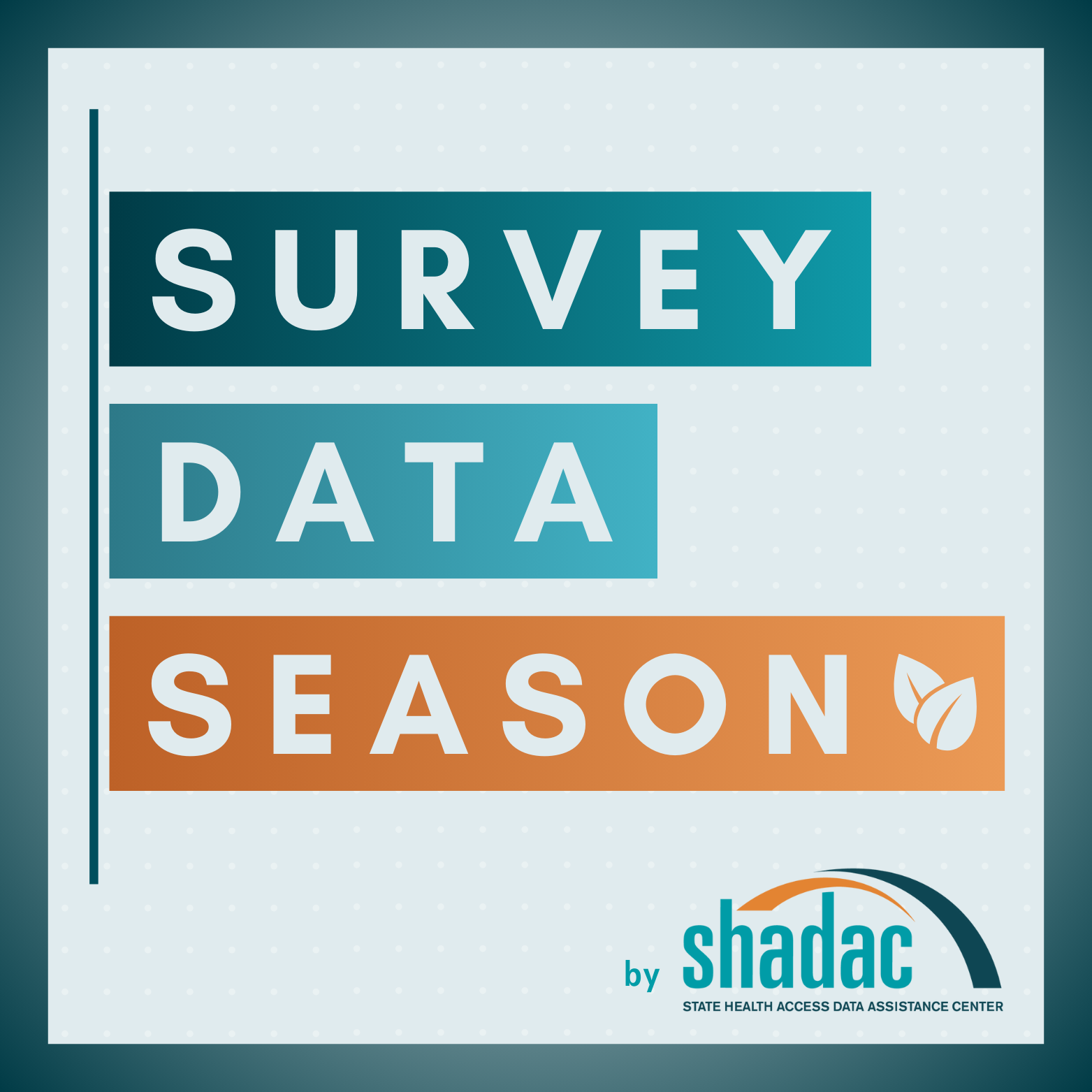This post is a part of our Survey Data Season series where we examine data from various surveys that are released annually from the summer through early fall. Find all of the Survey Data Season series posts on our Survey Data Season 2024 page here.
In late June, the National Center for Health Statistics (NCHS) released health insurance coverage estimates for 2023 from the National Health Interview Survey (NHIS) as part of the NHIS Early Release Program. The rates of insurance and uninsurance captured in this report are some of the first available coverage estimates for 2023 from a federal survey.**
National-level estimates are available by breakdowns including age, sex, family income (as a measure of poverty status), race and ethnicity, and by state Medicaid expansion status.[1]
In this post, we will examine this newly released 2023 NHIS data, delving into demographic breakdowns and their impacts on uninsurance rates.
All Age Groups Saw Uninsured Rates Fall in 2023
The uninsured rate for all ages was 7.6% in 2023 -- a statistically significant change from a rate of 8.4% in 2022, representing 2.6 million people.
Figure 1: Rates of Public, Private, and Uninsured for All Age Groups in 2023
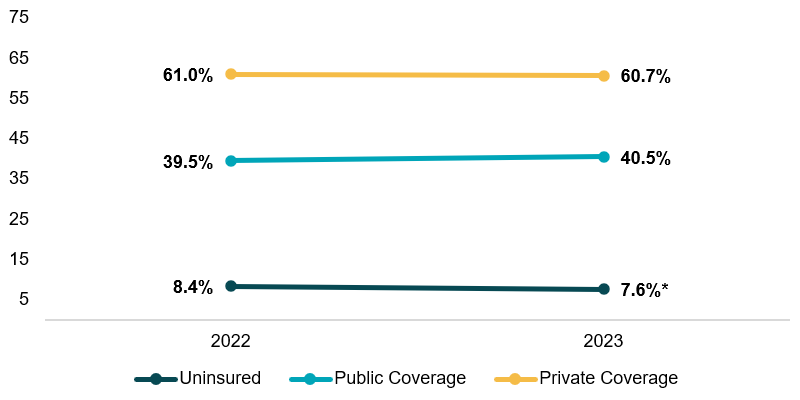
Source: SHADAC analysis of health insurance coverage data from the 2023 National Health Interview Survey (NHIS).
*Statistically significant change at the 95% confidence level.
Rates of public and private insurance coverage were statistically unchanged across all ages from 2022 to 2023, however; with the former coming in at a rate of 40.5% in 2023 (39.5% in 2022) and the latter showing at 60.7% in 2023 (61% in 2022).
Uninsured Rates Fell for Subgroups of Nonelderly Adults (18-64)
Nonelderly adults (age 18 to 64) saw the most coverage changes across demographic categories from 2022 to 2023. Overall, their uninsured rate fell significantly from 12.2% in 2022 to 10.9% in 2023.
Figure 2: Public, Private, and Uninsured Rates for Nonelderly Adults (Age 18-64)
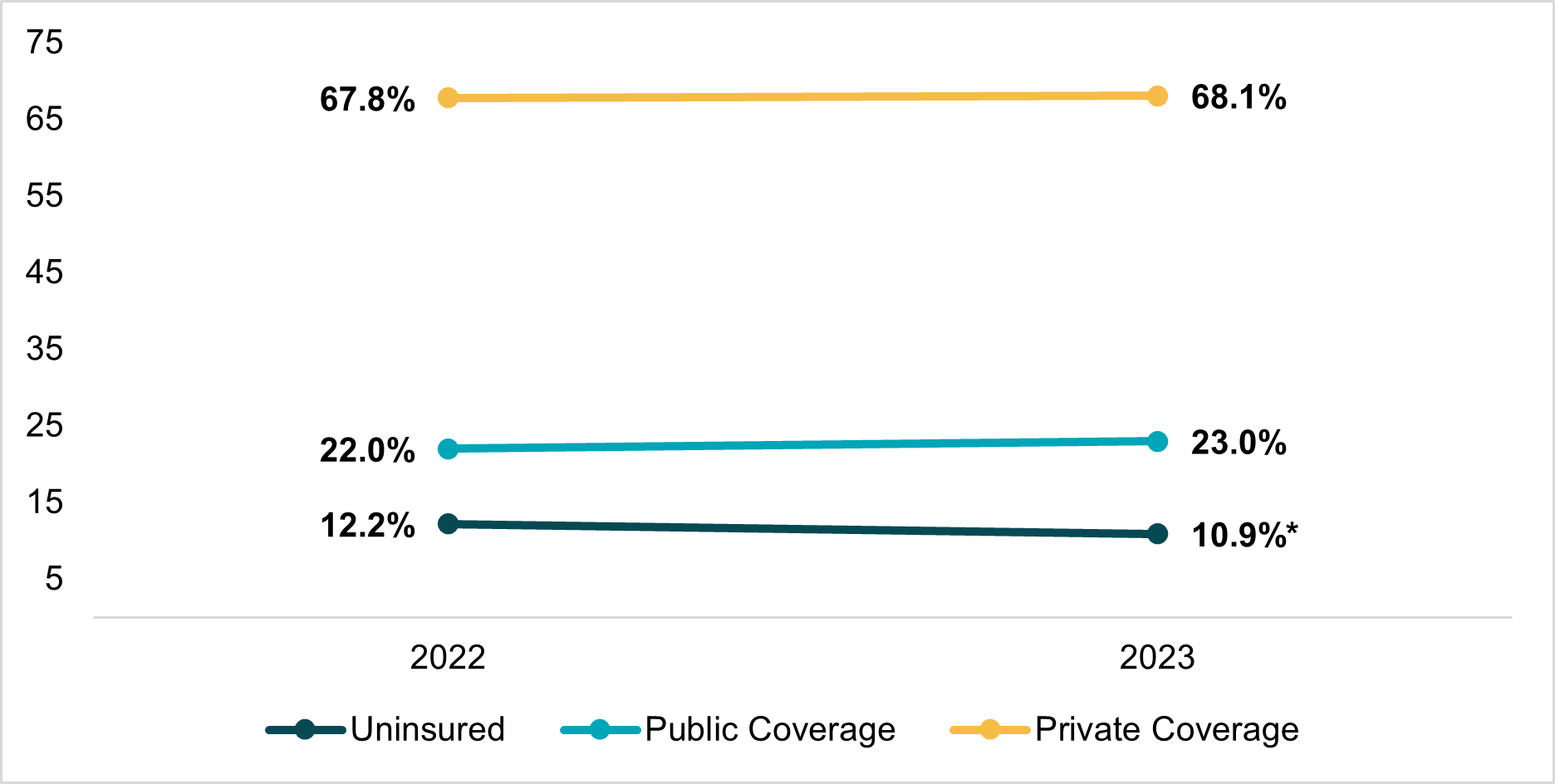
Source: SHADAC analysis of health insurance coverage data from the 2023 National Health Interview Survey (NHIS).
*Statistically significant change at the 95% confidence level.
Nonelderly adults were also the group that most consistently saw changes by demographic category.
Family Income (Poverty Status)
Of the four family income levels measured as a percentage of poverty status, two of those showed nonelderly adults experiencing significant decreases in uninsured rates from 2022 to 2023. For those whose income measured 100-199% of the Federal Poverty Level (FPL), uninsurance dropped from 22.3% to 19.1% between the two years, and for those in the 200-400% FPL category, uninsurance dropped from 14.2% to 11.5%.
Figure 3: Nonelderly Adults Uninsurance Rate by Family Income Levels Measures as a Percentage of Poverty Status
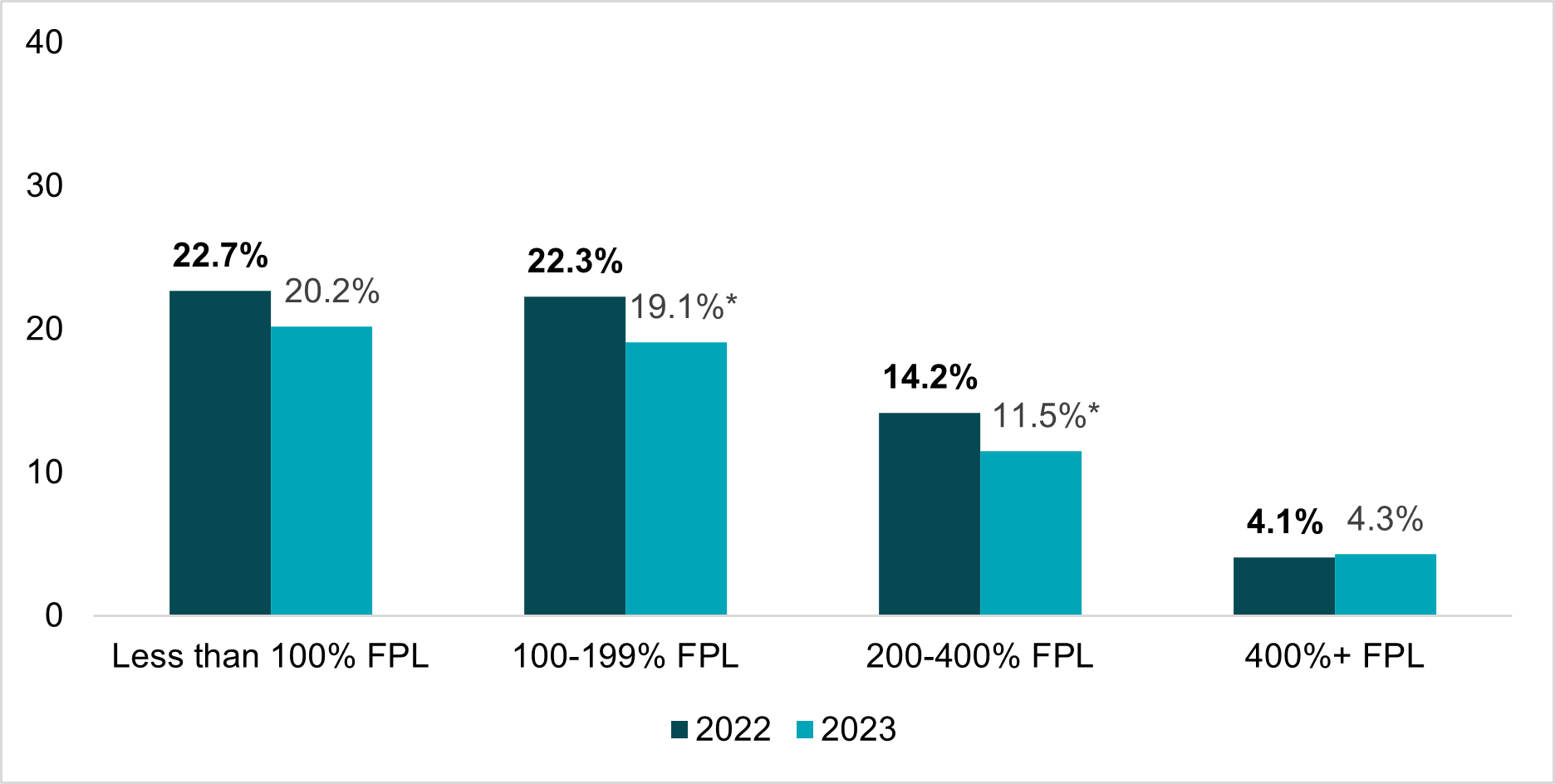
Source: SHADAC analysis of health insurance coverage data from the 2023 National Health Interview Survey (NHIS).
*Statistically significant change at the 95% confidence level.
Also of note for this age group: nonelderly adults with income measuring 200-400% FPL saw a significant rise in private insurance coverage, increasing from 68.7% in 2022 to 71.1% in 2023 – the only statistically significant change by poverty status for ay type of coverage other than uninsurance.
Race/Ethnicity
Changes in health insurance coverage type for nonelderly adults (18-64) between 2022 and 2023 were much more varied when examining rates for different racial and ethnic groups.
For instance, both Asian nonelderly adults and Black nonelderly adults saw significant decreases in uninsured rates, falling from 7.1% (2022) to 4.4% (2023) for the former and 13.3% (2022) to 10.4% (2023) for the latter.
Figure 4: Nonelderly Adults Uninsurance Rate by Race/Ethnicity
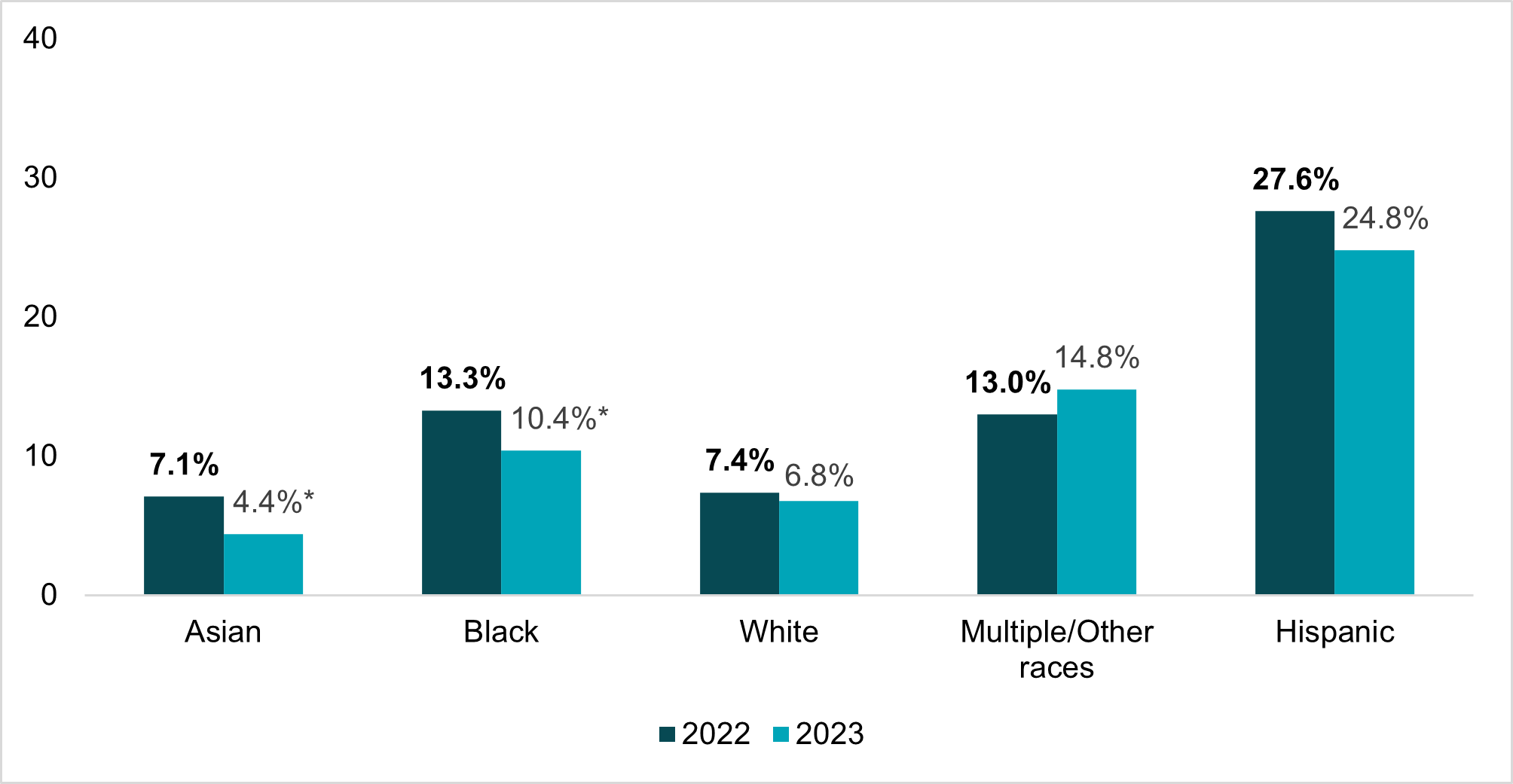
Source: SHADAC analysis of health insurance coverage data from the 2023 National Health Interview Survey (NHIS).
*Statistically significant change at the 95% confidence level.
Asian nonelderly adults also saw a rise in private coverage, increasing from 75.5% in 2022 to 80.3% in 2023.
Another notable increase was the rise in public coverage for Hispanic nonelderly adults in 2023, measuring at 27.5% from a rate of 23.7% in 2022.
Other Demographic Categories
The 2023 NHIS Early Estimate report also contains data about health insurance coverage estimates by sex and by state Medicaid Expansion status. However, no statistically significant changes were found for either of these categories for any type of coverage (no coverage, public coverage, private coverage) or for any age group (Under 65, 0-17, 18-64).
Notes About the Estimates
All changes described compare full-year 2022 data to full-year 2023 data and are statistically significant at the 95% confidence level unless otherwise specified.
All category breakdowns (Sex, Income, Race/Ethnicity, and Medicaid Expansion Status) refer to nonelderly adults, age 0-64, since adults 65 and older are eligible for Medicare (which tends to be their primary source of coverage). Thus, they represent a very small portion of the NHIS data for other coverage types that is unable to be broken down into subcategories.
The estimates provide a point-in-time measure of health insurance coverage, indicating the percent of persons with that type of coverage at the time of the interview.
**The health insurance data from the NHIS data are the first coverage estimates from 2023, the year in which the process commonly known as or referred to as the “Medicaid unwinding” began. The unwinding refers to the end of the requirement that Medicaid coverage for current enrollees be automatically renewed. This requirement ended on March 31, 2023, and on April 1, 2023, states began redetermination processes. Because of this mid-year shift, 2023 full-year estimates may not fully reflect the impact of the unwinding on health insurance coverage changes.
Upcoming and Related Products
As noted earlier, these health insurance data from the NHIS are the first coverage estimates that reflect the full year of 2023. Data from other major federal surveys – the Medical Expenditure Panel Survey (MEPS), the Behavior Risk Factor Surveillance Systems (BRFSS), the Current Population Survey (CPS), and the American Community Survey (ACS) – will be released over the coming few months, culminating in September.
SHADAC will be covering each of these releases, as we do every year, with a blog, infographic, report, or other product that shares key findings or important data to note from all surveys. Continue to follow us for more information, and watch for notices about our annual webinar with the U.S. Census Bureau, where they will talk more in depth about estimates from two surveys they manage – the ACS and the CPS.
Head over to this page to find an archive of all products released as a part of this ‘Fall Data Release’ series.
Source
Cohen, R.A., Briones, E.M., & Martinez, M.E. (2024, June 18). Health insurance coverage: Early release of estimates from the National Health Interview Survey, 2023. National Center for Health Statistics (NCHS). https://www.cdc.gov/nchs/data/nhis/earlyrelease/insur202406.pdf
[1] The NHIS full-year estimates for 2023 do not include any state-level data, as has been the case since the survey was redesigned in 2019. However, NCHS periodically releases state-level estimates of coverage via specialized National Health Statistics Reports which can be found here.

